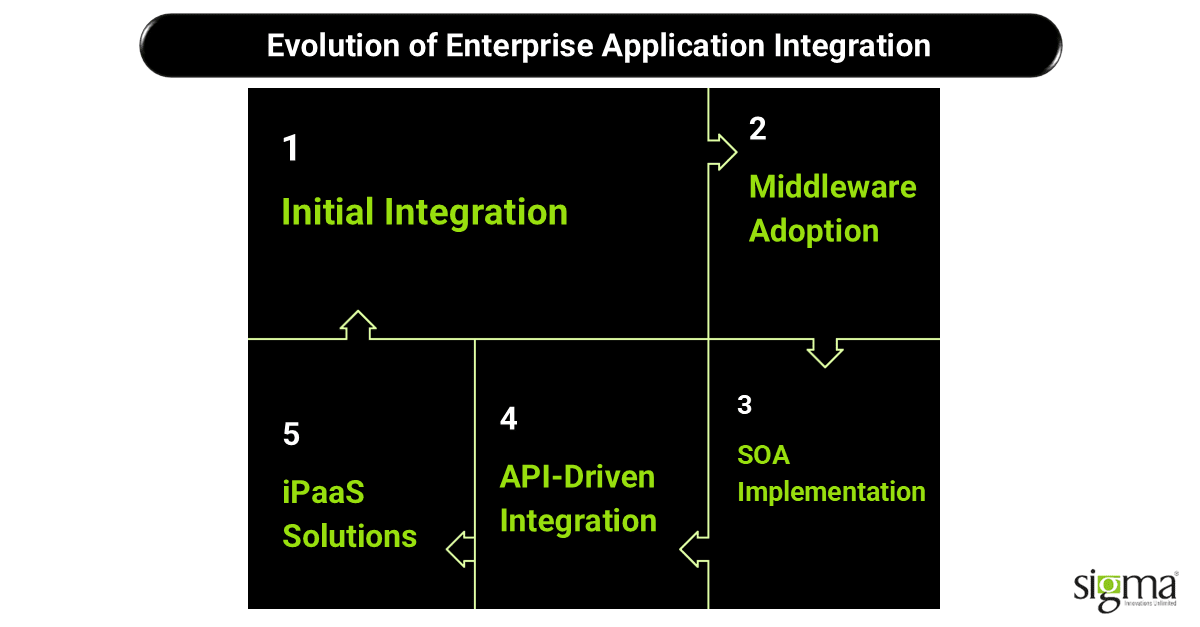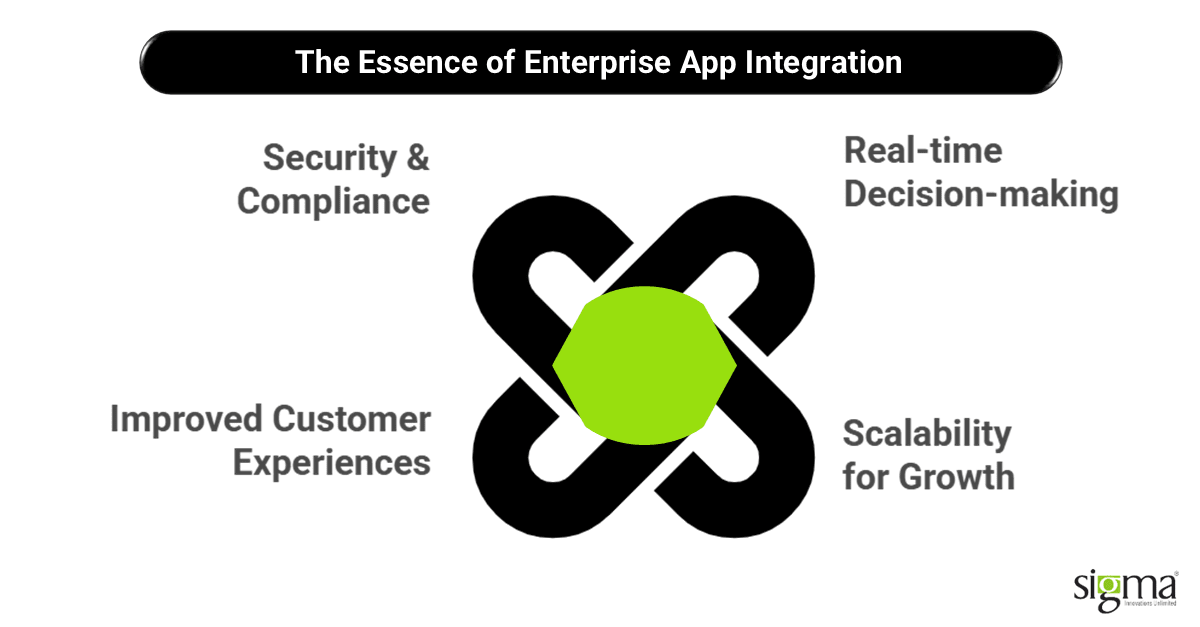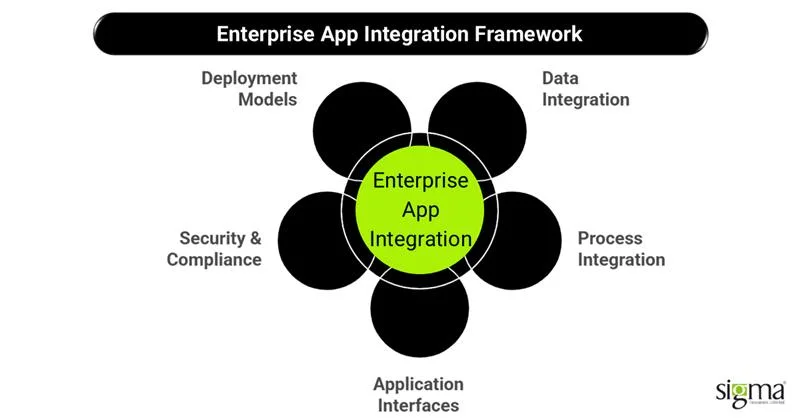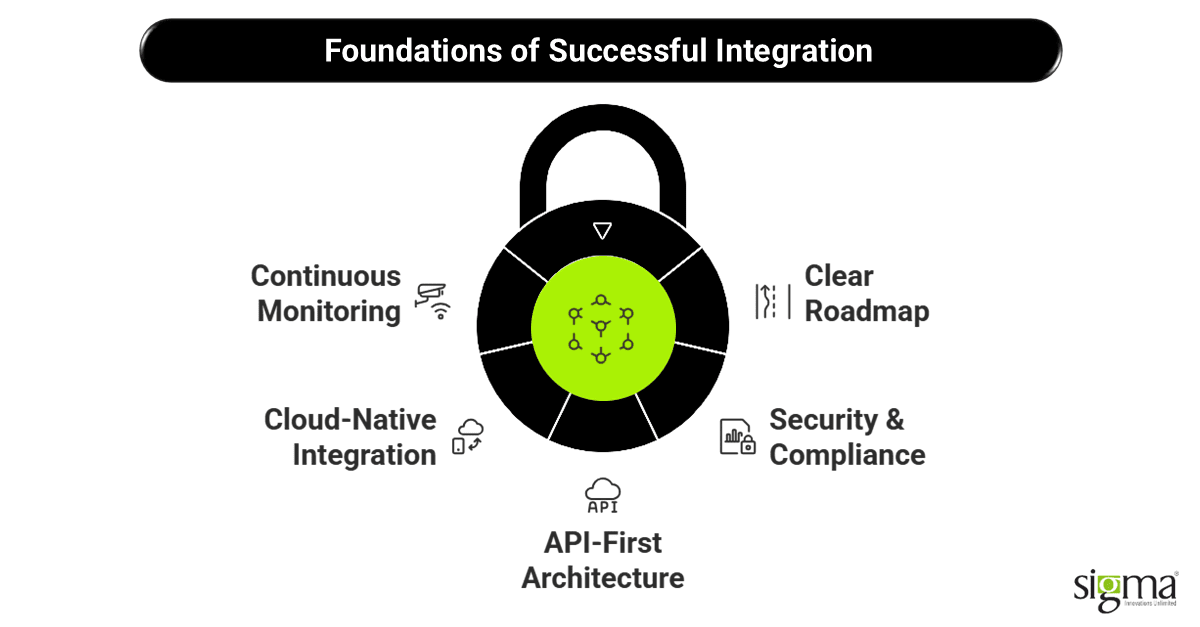Breaking Down Enterprise App Integration Services: How It All Connects
Key Takeaways:
- Enterprise Application Integration (EAI) unifies diverse business systems for seamless data flow and improved efficiency.
- Objectives of EAI: streamline workflows, enable interoperability, and empower real-time decision-making.
- Evolution of EAI: from point-to-point connections to modern iPaaS and API-driven architectures.
- Core Components: middleware, APIs, cloud platforms, and data integration tools.
- Benefits: enhanced productivity, reduced manual effort, improved visibility, and scalability.
- Challenges: data silos, security, legacy systems, and scaling issues—and how modern integration overcomes them.
- Use Cases: eCommerce (Magento/Shopify + ERP/CRM), fintech (loan origination + compliance), healthcare (EMR + billing), manufacturing (IoT + ERP).
- Sigma Infosolutions’ Expertise: end-to-end integration across eCommerce, fintech, BI & analytics, and cloud.
Imagine running a business where your sales team uses one platform, your finance department relies on another, and your customer support team is juggling yet another tool—with none of them “talking” to each other. That’s like having a band where every musician is playing a different song at the same time. Modern enterprises can’t afford that kind of chaos. Disconnected systems slow down decisions, frustrate employees, and create data blind spots that cost both time and money.
This is where Enterprise Application Integration (EAI) steps in. Simply put, EAI is the practice of connecting different business applications—CRM, ERP, payment gateways, analytics dashboards, and more—so they work together seamlessly as one ecosystem. Instead of teams wasting hours transferring data manually, integration ensures real-time data synchronization and streamlined enterprise workflows, unlocking faster, smarter, and more automated decision-making.
In this blog, we’ll break down what enterprise application integration services are all about. We’ll compare platforms, explore different tools and strategies, and highlight how businesses can leverage system integration solutions to simplify operations, cut costs, and scale faster.
At Sigma Infosolutions, we’ve spent years helping enterprises in eCommerce, fintech, SaaS, and beyond connect the dots through custom development services and end-to-end integration solutions. Whether it’s custom API integration for enterprises, modern cloud-based connectors, or advanced automation, our goal has always been to help businesses run like a perfectly tuned orchestra—every system in sync, every process connected.
What is Enterprise Application Integration?
At its core, Enterprise Application Integration (EAI) is about making all your business applications work together like one big connected system. Instead of treating your CRM, ERP, HR, and finance tools as isolated “islands,” EAI builds the bridges that allow data to move freely and securely between them. In simple terms, it’s the glue that keeps an enterprise’s digital ecosystem in sync.

The main objectives of enterprise application integration services are straightforward:
- Data flow automation – no more manual exports or endless spreadsheets. Information moves automatically across systems.
- System interoperability – different platforms and apps can communicate, even if they weren’t originally designed to.
- Improved decision-making – with real-time data synchronization, leaders get a single source of truth, which means faster, smarter business decisions.
EAI has come a long way from its early days. Initially, integration was handled with point-to-point connections—essentially wiring one system directly to another. That worked for small setups but quickly became messy as enterprises grew. Over time, businesses moved to middleware and service-oriented architectures (SOA) to simplify integration. Today, modern companies rely on API-driven integration and iPaaS (Integration Platform as a Service) solutions that offer scalable, cloud-based, and highly flexible ways to connect applications.
Why Enterprise App Integration Matters
The pace of business in recent times doesn’t leave much room for slow, disconnected systems. Whether you’re in eCommerce, fintech, healthcare, or manufacturing, decisions need to happen in real time, customer expectations are sky-high, and compliance rules are getting tighter. That’s why enterprise application integration (EAI) is no longer optional—it’s a core part of how modern enterprises stay competitive.

Key Business Drivers
- Real-time decision-making: In today’s data-driven world, waiting hours—or even minutes—for reports is a luxury. With real-time data synchronization, leaders can spot trends instantly, prevent bottlenecks, and act on accurate insights the moment they’re available.
- Scalability for growth: As companies expand into new markets or launch new products, system integration solutions allow them to plug in new applications without breaking existing workflows.
- Improved customer experiences: Customers expect seamless interactions—whether that’s checking out on an eCommerce site, getting instant loan approval in fintech, or accessing digital health records in healthcare. Application integration services ensure data flows smoothly to deliver frictionless customer experiences.
- Security & compliance: With stricter data privacy laws (like GDPR and CCPA) and industry mandates, integrated systems help organizations maintain secure financial data integration and audit-ready compliance.
Trends Defining 2025
According to Gartner, 90% of organizations are expected to adopt a hybrid cloud strategy by 2027. AWS and Oracle Cloud are doubling down on integration services powered by AI and machine learning, focusing on automated business process integration and predictive insights. Meanwhile, custom API integration for enterprises is becoming the backbone of modern digital transformation, enabling flexibility without lock-in.
Industries Most Impacted
- eCommerce: From payment gateway and CRM integrations to personalized shopping powered by analytics, integration is what drives faster sales cycles and better user experiences.
- Fintech: Secure, compliant, and real-time financial data integration is the lifeline for digital lending, payments, and fraud detection.
- Healthcare: Integration bridges electronic health records, wearables, and patient portals, enabling better care outcomes.
- Manufacturing: Connected supply chains and IoT-driven operations rely on end-to-end integration services for efficiency and cost savings.
In the future , enterprise application integration services will be less about “nice to have” and more about “must have.” They’re the silent force helping businesses stay agile, customer-focused, and future-ready.
Also Read: Unlocking Business Growth with Agile Custom Development Services
Core Components of Enterprise App Integration
Successful enterprise application integration isn’t just about connecting systems; it’s about building a reliable framework where every piece works in harmony. Let’s break down the core components that make application integration services effective in 2025.

1. Data Integration
Think of data as the lifeblood of your enterprise. Without proper flow, operations stall. Data integration ensures that information collected from different systems—ERP, CRM, HRM, or eCommerce platforms—moves smoothly into a unified environment. Tools like ETL (Extract, Transform, Load) processes, data lakes, and BI platforms such as Power BI and Tableau make it possible to generate actionable insights. This fuels real-time data synchronization and smarter reporting.
2. Process Integration
Enterprises rely on dozens of workflows: order fulfillment, payroll, customer onboarding, and more. Process integration connects these workflows across ERP, CRM, HRM, and custom development services so that everything runs without manual intervention. For example, when a new customer order hits your eCommerce site, inventory updates, billing, and shipping can happen automatically through automated business process integration.
3. Application Interfaces
Applications need a common language to talk to each other. That’s where custom API integration, Enterprise Service Buses (ESBs), and middleware come in. These act as translators, enabling system integration solutions to link legacy systems with modern SaaS apps. Whether it’s third-party API integration for SaaS apps or building flexible connectors for cloud tools, this layer ensures seamless communication.
4. Security & Compliance Layer
With sensitive data constantly moving across systems, security can’t be an afterthought. Authentication protocols, data encryption, and governance frameworks help organizations maintain compliance with GDPR, HIPAA, and PCI-DSS. For fintech and healthcare especially, secure financial data integration is critical for trust and regulatory audits.
5. Deployment Models: Cloud, On-Prem, or Hybrid
Every enterprise has different needs. Some prefer cloud integration for scalability and cost savings, others rely on on-premises systems for tighter control, and many adopt a hybrid integration model to get the best of both worlds. The rise of end-to-end integration services powered by iPaaS platforms makes hybrid adoption easier than ever.
In short, the strength of enterprise application integration services lies in combining these components into one well-orchestrated ecosystem. When done right, they empower enterprises with flexibility, security, and efficiency—all while future-proofing operations.
Enterprise App Integration Approaches: A Comparative View
There’s no “one-size-fits-all” approach when it comes to enterprise application integration services. Enterprises choose strategies based on scalability, budget, and the complexity of their IT ecosystem. Here’s a breakdown of the most common approaches:
1. Point-to-Point Integration: This is the simplest method—directly connecting two systems. While quick to implement, it becomes messy as the number of applications grows. Limited scalability makes it impractical for large enterprises.
2. Enterprise Service Bus (ESB): An ESB acts like a central hub where all applications connect. It’s structured and reliable, offering better scalability than point-to-point. However, it requires strong governance and can be complex to maintain.
3. API-led Integration: Modern enterprises often rely on custom API integration. It’s flexible, cloud-friendly, and supports real-time data synchronization. API-driven approaches are the backbone of digital transformation, making them ideal for fast-moving industries.
4. iPaaS (Integration Platform as a Service): iPaaS solutions, offered by providers like AWS, MuleSoft, and Dell Boomi, deliver end-to-end integration services from the cloud. They scale easily, support hybrid models, and reduce infrastructure costs, making them perfect for enterprises embracing multi-cloud strategies.
5. Robotic Process Automation (RPA): RPA isn’t a replacement for integration but a complementary layer. It handles repetitive, rule-based tasks like data entry or reconciliation, boosting efficiency alongside EAI.
6. Custom-Built Integration: When out-of-the-box solutions won’t cut it, enterprises opt for custom development services to build tailored integrations. While this offers maximum flexibility, it comes with higher costs and long-term maintenance challenges.
Comparative Table of Integration Approaches
| Approach | Scalability | Cost | Complexity | Best Fit Use Case |
|---|---|---|---|---|
| Point-to-Point | Low | Low | Low | Small setups with few apps |
| ESB | Medium–High | Medium | High | Enterprises with legacy systems |
| API-led Integration | High | Medium | Medium | Digital-first enterprises |
| iPaaS | Very High | Medium | Low–Medium | Cloud-first, hybrid enterprises |
| RPA | Medium | Low–Medium | Low | Automating repetitive tasks |
| Custom-Built Integration | High | High | High | Niche use cases, industry-specific needs |
Key Tools & Platforms for Enterprise App Integration
Choosing the right platform for enterprise application integration services depends on your business size, industry, and growth goals. Let’s look at some of the leading tools powering application integration services in 2025:
- AWS AppFlow & AWS Integration Services – Ideal for enterprises already leveraging the AWS ecosystem. They offer end-to-end integration services, secure data transfer between SaaS apps, and strong scalability for cloud-first businesses.
Leverage Sigma’s AWS Cloud end-to-end integration services - MuleSoft (Salesforce) – Known for its API-led integration approach, MuleSoft is a top pick for enterprises needing flexibility and real-time connectivity across on-premise and cloud. It’s especially strong for digital-first companies in finance, healthcare, and retail.
- Oracle Integration Cloud – A favorite among large enterprises with deep investments in Oracle ERP or databases. It provides advanced automated business process integration and strong compliance capabilities.
- Microsoft Azure Logic Apps & Power Automate – Perfect for enterprises in the Microsoft ecosystem. With low-code design, they make custom API integration and workflow automation easy for both IT teams and business users.
- Dell Boomi – One of the most popular iPaaS platforms, Boomi focuses on agility, hybrid cloud connectivity, and prebuilt connectors. Mid-to-large enterprises across eCommerce and manufacturing often choose it for system integration solutions.
- Appian / OutSystems – Low-code platforms designed for enterprises that want speed. They’re best suited for building custom workflows quickly, especially when paired with custom development services for more complex needs.
Comparative Insights
- For cloud-first companies: AWS AppFlow or Dell Boomi are excellent fits.
- For enterprises with heavy legacy systems: Oracle Integration Cloud or ESB-based MuleSoft solutions shine.
- For Microsoft-focused enterprises: Azure Logic Apps & Power Automate bring seamless synergy.
- For fast-scaling enterprises needing low-code agility: Appian and OutSystems reduce time-to-market.
In short, the best platform depends on where your enterprise already invests, and how scalable and flexible you need your system integration solutions to be.
Also Read: How Product Engineering Services Power the Entire Product Lifecycle
Best Practices for Successful Integration
Implementing enterprise application integration services isn’t just about choosing the right tool—it’s about building a strategy that sticks. Many enterprises jump into integration projects only to realize later that costs balloon or security gaps emerge. To avoid that, here are some best practices that leading organizations follow in 2025.

1. Start with a Clear Roadmap & Business Case: Integration should never be a “nice-to-have” project. Define why you’re doing it—whether that’s streamlining enterprise workflows, scaling operations, or improving customer experiences. A clear roadmap aligns IT goals with business outcomes.
2. Ensure Security & Compliance by Design: With increasing regulations like GDPR, HIPAA, and PCI-DSS, enterprises need system integration solutions that bake in authentication, encryption, and governance from the start. This is especially critical for industries handling sensitive data, such as fintech and healthcare.
3. Adopt an API-First Architecture: Modern integration thrives on custom API integration. By designing APIs as the primary connectors, enterprises unlock flexibility, scalability, and easier third-party adoption—whether it’s payment gateway and CRM integrations or industry-specific SaaS apps.
4. Leverage Cloud-Native Integration: Cloud-first models like iPaaS reduce infrastructure overhead and make end-to-end integration services more agile. A hybrid model works well for enterprises balancing legacy on-prem systems with modern cloud apps.
5. Continuous Monitoring & Performance Optimization: Integration isn’t a “set it and forget it” solution. Continuous monitoring helps track data flows, prevent bottlenecks, and optimize performance for long-term ROI.
Partner with Experienced Tech Consultants
Even the best platforms need skilled hands to implement them. This is where custom development services and expert guidance matter. At Sigma Infosolutions, we bring years of experience in enterprise application integration, from eCommerce and fintech to healthcare and manufacturing. Our approach blends application integration services, security-first design, and scalable architectures—so enterprises can focus on growth while we handle the complexity.
Leverage Sigma’s Custom Development Offerings for Enterprise App Integration (EAI) Services
Real-World Use Cases of Enterprise App Integration
The value of enterprise application integration services becomes clear when you look at how different industries apply them. Here are some real-world examples:
eCommerce
Retailers running platforms like Magento, Shopify, WooCommerce, or BigCommerce can’t operate in silos. By integrating eCommerce stores with ERP, CRM, and BI platforms, businesses achieve real-time data synchronization—from inventory management to personalized customer insights. The result? Faster order fulfillment, better demand forecasting, and higher customer satisfaction.
Fintech
In lending, speed and compliance are everything. By integrating loan origination systems with credit scoring platforms, compliance checks, and analytics dashboards, fintech companies automate approvals, reduce fraud risk, and ensure regulatory alignment. Here, custom API integration plays a major role in connecting third-party verification tools and compliance systems.
Healthcare
Healthcare providers rely on Electronic Medical Records (EMRs), billing systems, and compliance platforms. Integration makes it possible to unify patient data, streamline billing, and stay aligned with HIPAA regulations. This ensures better patient experiences and improved operational efficiency—all powered by system integration solutions with strict security layers.
Manufacturing
Modern manufacturers need visibility across supply chains, production, and IoT devices. By connecting ERP systems with IoT platforms and supplier networks, businesses gain end-to-end integration services that enable predictive maintenance, reduced downtime, and smarter resource allocation.
How Sigma Infosolutions Enables Seamless Enterprise Integration
At Sigma Infosolutions, we understand that integration is more than just connecting applications—it’s about creating a unified ecosystem that drives growth, scalability, and efficiency. With nearly two decades of experience, we specialize in delivering scalable, secure, and business-centric integration solutions tailored to diverse industries.
eCommerce Expertise
We help online retailers streamline operations by integrating platforms like Adobe Commerce (Magento), Shopify, WooCommerce, and BigCommerce with ERP, CRM, and BI systems. This ensures real-time data flow across sales, inventory, and customer management, driving better decision-making and customer experiences.
Fintech Integrations
Our team enables lenders and fintechs to build smarter, compliant ecosystems by integrating loan origination systems, credit scoring engines, BI dashboards, and regulatory compliance platforms. This empowers faster decision-making, reduces risks, and enhances profitability.
BI & Analytics
Sigma leverages tools like Power BI, Tableau, and advanced custom dashboards to centralize reporting across multiple data sources. By turning raw data into actionable insights, we empower organizations with visibility and predictive intelligence.
Cloud & Custom APIs
With strong capabilities in AWS, Salesforce, and custom API development, Sigma builds cloud-native and API-first integration frameworks that support agility and long-term scalability.
By combining deep technical expertise with business understanding, Sigma Infosolutions ensures seamless enterprise application integration services that transform fragmented systems into connected digital ecosystems.
Final Thoughts
As enterprises continue to evolve in 2025 and beyond, Enterprise Application Integration (EAI) is no longer a nice-to-have—it’s a strategic necessity. Businesses that fail to unify their systems risk inefficiencies, data silos, and missed opportunities, while those that embrace integration gain agility, visibility, and a competitive edge. From streamlining operations to unlocking real-time insights, EAI serves as the backbone of digital transformation.
For decision-makers, the next step is clear: assess your current integration maturity. Are your core systems communicating seamlessly? Do you have a unified view of data across departments? Is your infrastructure ready to scale securely as your business grows? Honest answers to these questions reveal where integration gaps may be slowing innovation.
At Sigma Infosolutions, we specialize in tailored enterprise integration solutions that are scalable, secure, and aligned with your business goals. Whether you’re in eCommerce, fintech, healthcare, or manufacturing, our experts can help you design and implement an integration strategy that future-proofs your enterprise.
Connect with Sigma Infosolutions today to explore how we can transform your fragmented systems into a connected digital ecosystem!
